 Few things feel as exciting as riding an electric scooter or e-bike, making you feel as though you’re starring in your own version of Back To The Future. Rather than Marty McFly’s hoverboard, however, these are scooters and bikes that have electric batteries, thereby allowing you to move from place to place whilst making very little effort.
Few things feel as exciting as riding an electric scooter or e-bike, making you feel as though you’re starring in your own version of Back To The Future. Rather than Marty McFly’s hoverboard, however, these are scooters and bikes that have electric batteries, thereby allowing you to move from place to place whilst making very little effort.
Deciding on the right one to buy can be a big challenge, especially when you consider just how many of them there are on the market. That is where this buying guide comes in, helping you to figure out the right way forward on your electric scooter or e-bike buying journey. Just as with the scooters and bikes themselves, we’re aiming to make things as smooth as we possibly can.
Shops With Electric Scooter Offers
Electric Scooter Buying Guide
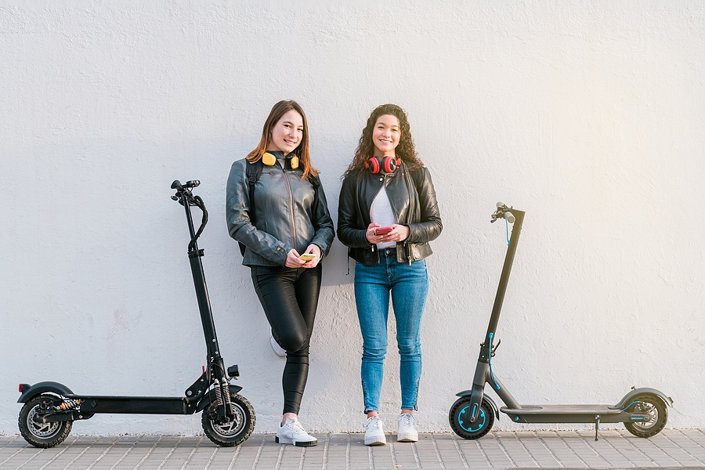
Generally speaking, we’re absolutely spoilt rotten in terms of the technology that is available to us. It is one thing to be able to turn on the lights without even standing up, courtesy of smart speakers, but something else entirely to be able to move from one place to the other without even having to engage our leg muscles. That is what electric scooters allow you to do, however, thanks to the manner in which they do the hard work for us and yet we still get where we want to go.
Electric bikes have shot up in popularity in the last few years of course, but even they require you to move your legs to propel them forwards. Electric scooters, meanwhile, can be used to travel short distances with little-to-no effort, with only the hand being used to tell it you want to move and the scooter doing the rest. Just because they’re such relatively simple things doesn’t mean that there isn’t plenty we can ask about them to figure out which one is the best for us, as you’ll discover here.
How They Work
One of the most important questions that you’ll doubtless want an answer to is how, exactly, electric scooters work. In reality, it is actually quite easy to get your head around how the machines operate, thanks to the fact that the battery is linked up to the motor by some wires. When you press the throttle on the scooter, the battery sends power to the motor, which moves the wheels and sends the device moving forwards. After it has begun its forwards journey, you then use the break to slow them down or stop them.
The sheer manoeuvrability of electric scooters is such that they don’t have a reverse function. Instead, you can use the handlebar to turn them around with an incredibly tight turning circle, allowing you to head off in the direction that you’ve just come from. If you wanted to you could even get off it, pick it up and turn it around, with the vast majority of the devices being light enough to allow such a quick change of direction. Whilst there are some small details that allow for variety, that is how most electric scooters operate.
Charging
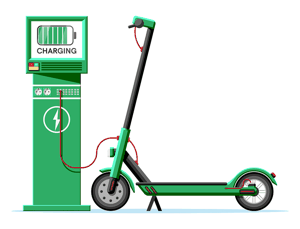 Electric scooters can be charged from your home power sockets, so all you need to do to charge them is remove the protective cover on the charging port, plug in one end of the cable and plug the other end into your power outlet at home. Once you’ve plugged in the scooter, the actual charging process will take a different amount of time depending on the model that you’ve bought. As an example, a 2.6 Ah battery with a 1 Amp plug will take about 2.6 hours to charge to 100%, whereas a 5 Amp plug would take 30 minutes.
Electric scooters can be charged from your home power sockets, so all you need to do to charge them is remove the protective cover on the charging port, plug in one end of the cable and plug the other end into your power outlet at home. Once you’ve plugged in the scooter, the actual charging process will take a different amount of time depending on the model that you’ve bought. As an example, a 2.6 Ah battery with a 1 Amp plug will take about 2.6 hours to charge to 100%, whereas a 5 Amp plug would take 30 minutes.
The exact charger that you’ll have will depend on the unique scooter, but they might use a USB-style charger, a DC coaxial plug or XLR charger, as an example. Each has its own quirks and some are more common than others, but they’ll work in much the same way as each other. The most important thing is that you get power to the lithium ion battery that allows your electric scooter to run. The charger will warm up during the charging process, but this is entirely normal and nothing to worry about, provided it doesn’t get too hot.
Range
Perhaps one of the most crucial questions when it comes to buying an electric scooter is how far it can go. This question leads to another question, of course, which is how far you’ll need it to go. Once you’ve figured out how far you’ll require your electric scooter to travel, you can then begin to look into the size of the battery available on the electric scooters on the market and make an informed decision about which one you think will be best for you. The bigger the battery, the further it will be able to go on one charge.
If you’re only needing the electric scooter for short journeys around your local area, smaller and more cost-effective batteries will be absolute fine for what you need. If, on the other, you’re planning to ride it quite a distance, for commuting to work, say, then you’ll need to look at scooters with larger batteries. This is also true if your journey is short but will ask a lot of the scooter, such as travelling up hill or over rough ground. The less you use the throttle and the slower you travel, the longer the battery will last.
Electric motors have a ‘rated’ power as well as a peak power outage. The higher the wattage of the battery, the more it will be able to produce power and therefore climb hills or provide decent acceleration. The heavier you are as a person, the more powerful you will need your battery to be in order to allow it to carry you at decent speeds or uphills. Most e-scooters will have a typical range of 15 to 20 miles, with 20 to 30 miles being the one up from that. Premium models can even travel as far as 50 miles before needing to be re-charged.
How Fast Can They Travel?
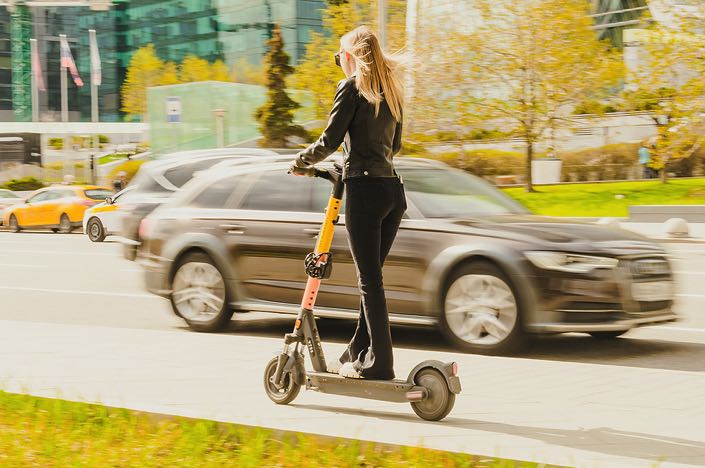
The majority of electric scooters have a maximum speed of 15 miles per hour. That might not sound like a massive speeds, but when you consider that you’re protected only by a helmet, it is a pretty decent speed. Some models can go a little bit faster, reaching as much as 18 mph, with others still able to hit the dizzying heights of 40 mph before topping out. Whilst it might seem cool to be able to go at decent speeds, the reality is that you’re travelling on a device with small wheels, making fast speeds quite dangerous.
The other thing to think about is the fact that electric scooters that go at fast speeds need bigger batteries as well as more powerful motors. This not only means that they’re more expensive but also that they’re much heavier, which can problematic for some people. There are several factors that dictate how quickly you’ll be able to travel, with the following being key ones:
- The terrain that you’re travelling on
- The weight of the rider
- The pressure of the tyres
- The size of the motor
You’ll need to bear all of this in mind when you’re reading the manufacturer’s quoted electric scooter speeds. They will usually be basing their speeds on a light rider, using the scooter on flat terrain and with tyres that are well-pumped. In truth, 15 miles per hour is more than good enough when you consider that the average walking speed is 4 mph and an average commuter on a bike will travel at about 14 mph. The desire to chase a fast speed is understandable, but is not the most sensible think to look for with your electric scooter.
Electric Scooter Comfort
One of the most important factors when it comes to deciding on the right electric scooter for you is the comfort of the ride. This might seem a bit weird when you consider that you’re standing up rather than sitting down, but you’re having to hold onto the handlebar of the scooter and poorly built ones can feel as though they’re shaking your bones when you go over anything other than an entirely flat surface. Those sorts of e-scooters can barely be ridden for more than a mile before they become too uncomfortable.
There are a range of difference factors that can have an affect on the quality of the ride that you experience, with the first one being the size of the wheel. Any wheels that are less than ten inches in diameter will result in a much rougher rider than is comfortable, to say nothing of the fact that they’ll struggle to get over a curb or out of a pothole. The more off-roading that you’re going to do, the fatter the tyre you’ll need. On top of that, you’ll also need decent suspension in order to stop the ride being far too bumpy for comfort.
Suspension works on electric scooters in much the same way as it does on any other form vehicle. It is there to remove shocks and smooth out the bumps where possible. How you’re planning to use your electric scooter will dictate how important the suspension will be to you. It will usually be either on the front wheel, the back wheel or both, with the latter obviously providing the most protection. Suspension is also the best way of avoiding the handlebar vibrating as you ride, which can add an extreme sense of discomfort.
What Type of Tyres Does It Have?
Electric scooters tend to have one of two types of tyre: air-filled or solid rubber. These can sometimes be referred to as either pneumatic or airless, but going with the former moniker makes it easier to understand. There’s no question that having air-filled tyres will give you a more comfortable ride. The air within the tyres will absorb shock, as well as provide you with better handling. The downside of that, however, is that they can get punctured and need to be repaired on a fairly regular basis, which can be frustrating.
Air-filled tyres require more maintenance, such as regularly checking your tyre’s air-pressure and topping it up when needs be. If they end up being under-inflated then this can have an affect on your battery as well as your speed. For some, opting for solid rubber tyres will be a more sensible way to go for the simple reason that they require next to no maintenance. The likes of glass, nails and thorns will make little difference to these tyre types, but the ride won’t be as smooth and you’ll feel far more of the bumps along the way.
Brakes
It might seem odd to discuss the type of brakes on your electric scooter when it comes to ride comfort, but actually these can make a big difference. Aside from anything else, the ability of the brakes to actually slow you down can be crucial to your enjoyment of your electric scooter. There are three types of brake that you’ll get on an electric scooter, with the most basic being foot brakes. These work by pressing your foot down on the rear mud guard, which in turn will go onto the wheel and literally stop it from moving.
As you might imagine, foot brakes are not the most comfortable for several reasons, so it is worth considering an e-scooter with disc brakes or drum brakes. Drum brakes are located inside the wheel hub and require less maintenance than other types of brake. They will often be the best-performing in wet weather, which is something to think about depending on where you live. Disk brakes, meanwhile, have the best stopping power and are quite light, allow for better speed. Both these brake times will wear over time.
Last but by no means least are electric or regenerative brakes. As the name suggests, they allow for the re-generation of your battery when you use them, which can be a real bonus. Whilst they are probably the least maintenance-heavy of the braking systems, they are also the least useful. If you’re travelling at a high speed and need to stop quickly, electric brakes are not going to be much use in allowing you to do so. This is a matter of comfort over usefulness, so that is a question that only you will know how to answer.
Is It Waterproof?
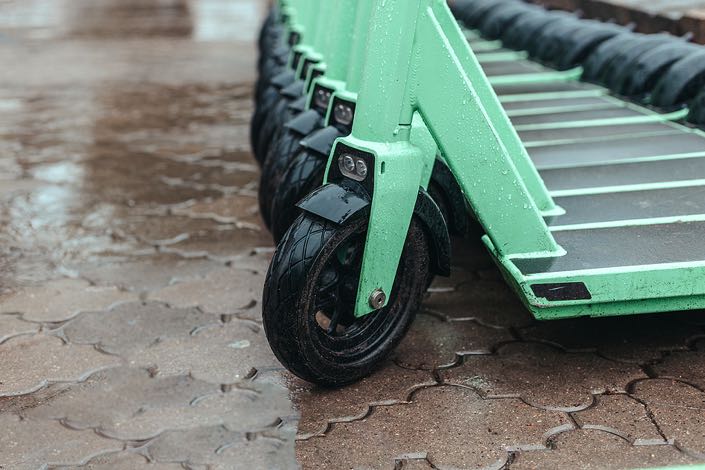
The vast majority of electric scooters on the market are not waterproof. To make matters worse, many manufacturers will put it in the small print that getting them wet will invalidate their warranty. This means that if you ride them in the rain or go through a particularly big puddle, you could damage your e-scooter and the people that made it will be unwilling to fix it under the warranty, meaning that you’ll have to pay for fixes out of your own pocket. This can end up costing as much as a brand new scooter.
Given the fact that most electric scooters are made in China and aimed at a Chinese market that enjoys a Chinese climate, you can end up paying a lot of money for a scooter that you can’t use in the United Kingdom without potentially damaging it. As a result, one of the most important questions that you might end up asking about your electric scooter is whether or not it is waterproof. You might end up paying a little bit more for a waterproof e-scooter, but not doing so can quickly prove to be a false economy.
Weight Limit
Not all electric scooters are made equal and this is never more clear than when considering how much weight they can handle. If you’re buying an e-scooter that is aimed at the European market then the chances are that it will have a maximum load amount of around 16 stone. That doesn’t mean that people over 16 stone don’t ride on them, but it does mean that those that do are probably invalidating their warranty. How heavy you are personally will dictate how important the weight limit of your scooter will be.
If you’re heavier than the maximum weight load of the electric scooter that you’re riding, it’s not just the warranty that could end up being problematic. You will also find that the scooters aren’t as able to climb hills or travel at fast speeds as you were probably hoping, as well as the fact that they will be less safe to ride. There are e-scooters out there that have been designed with heavier body types in mind, so they’re worth searching out if you think you’re going to be asking your electric scooter to carry excess weight.
What the Law Says
At the time of writing, electric scooters can only be ridden legally on private land. The only scooters that be ridden legally are those that are part of the government trials on e-scooters, so those that own their own will be breaking the law if they take them out on pavements or cycle-lanes. The whole point of the government scheme, of course, is to figure out whether allowing scooters to be ridden in public is a sensible way forward. With this in mind, it is worth checking what the law says at the time that you’re considering buying an e-scooter.
Because there is currently no specific law for electric scooters, they come under the bracket of ‘powered transporters’. This means that they face the same laws and regulations as other motor vehicles, resulting in the need for licences, MOTs and tax, to name but a few things. They lack number plates, rear lights and the ability to signal, making them illegal. You also need to have a category Q entitlement on your driving licence to legally drive them, which is obviously something worth considering.
Electric Bike (e-Bike) Buying Guide
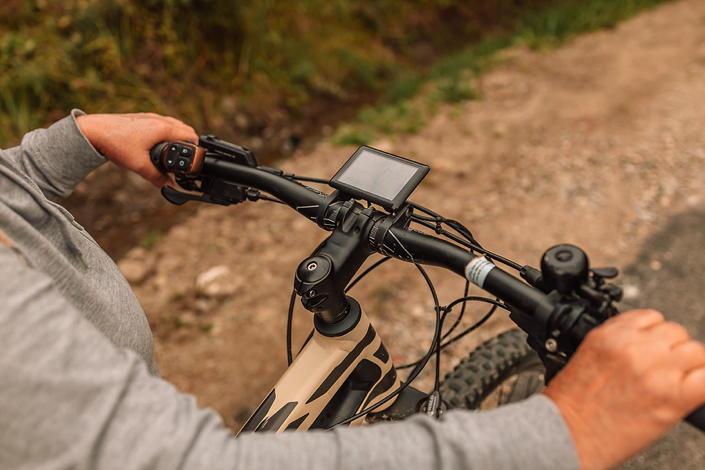
Just as electric scooters have started to become more and more popular, so too have electric bikes entered the market place as an option for people looking to get themselves from A to B at a rather more speedy pace. If you’re keen to have a healthier commute to work, for example, but want to avoid turning up at the office drenched in sweat and needing a shower, an e-bike might just provide you with a solution. The same is true if you enjoy getting out and about on a bike but the idea of having to pedal up a big hill is something that you’re really not all that keen on.
There are loads of reasons why you might want to get an electric bike, given the fact that they are both fun to ride and extremely practical. They are gaining in popularity with every passing week, thanks in no small part to the fact that they are available in all sorts of sizes and shapes. There will almost certainly be an option that suits your needs, with the environmentally-friendly nature of them appealing to the masses like never before. You will still get a workout riding one, but the motor on the bike will offer you a little bit of help and take the stress out of riding.
How Electric Bikes Work
As you might imagine, electric bikes work in different ways depending on the type that you’ve got. Those with a front hub motor see the electric ‘engine’ fitted onto the front of the bike, resulting in you effectively being pulled along as you go. This is the type of e-bike that you’re likely to find if you’ve opted for an entry-level version, working in a way that is not dissimilar to how front-wheel-drive cars tend to operate. Conversely, read hub motors are attached the the rear wheel of the bike and offer more traction than the front hub alternatives, giving a more stable feel.
The fact that they need to interact with the gears and the chain of the bike means that rear hub motors tend to be more technologically advanced. If you’re looking for a more natural feel to your e-bike riding, you might want to opt for the central-drive motors that are available. These sit on the bottom bracket of the e-bike, directing power through the entire chainset. The fact that the weight of the motor is in line with your centre of gravity also adds to the more natural feel of the riding, which is ideal for those that want the help with their riding but don’t want to have to change the way they ride.
Charging an e-Bike
Batteries on e-bikes come in different wattages, ranging from 200 watts to 550 watts. Which one you opt for will be one of the biggest decisions you make, with the larger wattage obviously tending to cost a little bit more. That is because the larger the wattage the more power is provided to the bike. When you go to charge your e-bike, you should make sure that you only use the charger that was provided. Each electronic bike will have its own method for charging, so make sure that you look at the manual and know exactly what it is that you’re doing before plugging in.
You will need to give your e-bike a full charge before heading out to use it for the first time and it is best to leave it plugged in for about 24 hours the first time. Normally, it will take between three and eight hours to charge, depending on the battery size, but each e-bike will be different. Once the battery is full, unplug your charger and try to charge it indoors when you can. Remember that the likes of cold and heat can both affect a battery’s charging ability. Always make sure that you’re charging your e-bike in a safe and secure location when you’re able to.
Different Types of e-Bikes
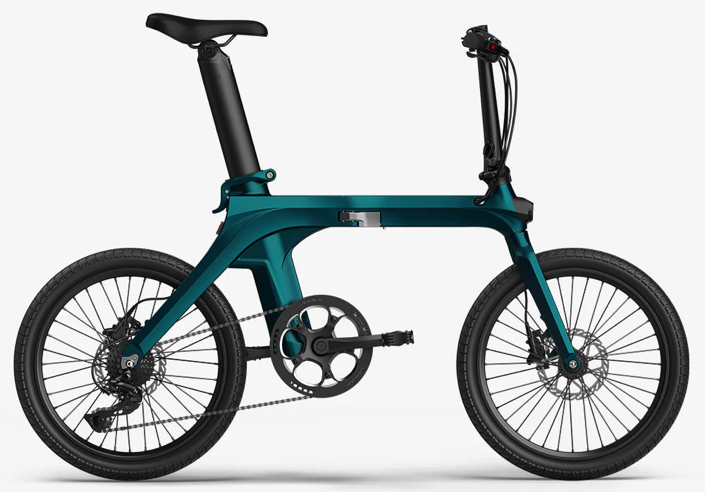
If you’re looking at getting an e-bike, you will want to make sure that you get the right one for you. There are several different types of e-bike, with the following being the most common:
Folding e-Bikes
If you’re the sort of person that tends to jump on the train for part of your commute before hopping on your e-bike in order to make it the rest of the way, a folding e-bike might well be for you. You can fold it and unfold it in a matter of seconds, which makes them easy to store. The wheels are small, which makes them smaller once they’re folded down but also tricky to go long distances. As a result, these are best for those of you looking to ride in the streets of a town or city, making them ideal for urban riding and commuting or for those with little space at home.
Electric Mountain Bikes
For a lot of people, the idea of having a folding e-bike won’t appeal because they want to get off-road as much as possible. If that is the category that you fall into then you might want to consider getting an electric mountain bike. You will still be able to go off-road, but you’ll have a little bit more help when the going gets tough, ensuring you’ll be able to be out for longer than you will have been in the past. Most of the big name brands offer electric mountain bikes, so there’s a good chance that you’ll be able to find your favourite mountain bike in e form.
Hybrid e-Bikes
Should you wish to get an e-bike that is neither outright mountain bike nor road bike, you might want to consider an electric hybrid. These bikes are able to tackle both rugged terrain and your commute to work, with flat handlebars sitting on bikes that tend to have mudguards and racks in order to offer you plenty of options of what to do. They are the most versatile of all e-bikes, so they are ideal for people that like to use their time cycling to do lots of everything. They aren’t designed to do one thing amazingly, just several things really well, which is worth thinking about.
What Is an e-Bike’s Range?
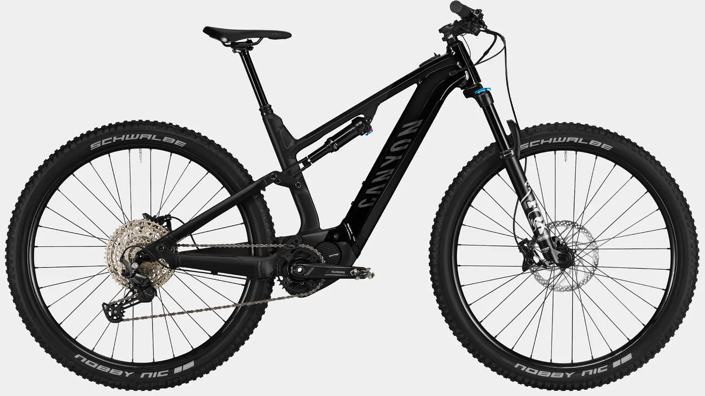
There are a few different factors that will impact how long an e-bike is likely to go. The total weight of the load, which includes both the rider and their gear, is a big part of things. The faster you look to ride, the more likely it is that the battery will deplete quicker. On average, you’ll be looking at anywhere from 20 miles to 100 miles from an e-bike before you’ll need to recharge it. This is worth bearing in mind when you’re trying to decide which e-bike is for you. Similarly, the roads that you ride in will have an impact, with bumpy roads liable to use up the batter quickly.
The other thing that you’ll find when you’re looking at how far your e-bike is likely to last is that the size of the battery is crucial. The bigger the battery, the longer the distance that you’ll likely get out of your e-bike. The type of battery that you have as well as the condition that it is in will also be key in getting longer distances out of your e-bike. Ensuring that you have your tyres pumped up, can ride on smooth surfaces where possible and understand the best gear to be in at any given moment will all help you get the most out of the battery on your e-bike.
Are e-Bikes Legal?
Unlike with electric scooters, that tend to have more rigorous rules in place around their use, there are fewer things to worry about when it comes to the legality of an electric bike. That being said, you do need to be 14 or older in order to ride an e-bike, whilst the law in the UK does say that pedelecs, which is the short name of pedal assisted electric bicycles, cannot have motor power of more than 250 watts. Just because they do go up to 550 watts, therefore, doesn’t mean that you should be buying one unless you plan to use it on your own private land.
The maximum speed for e-bikes in the United Kingdom is 15.5 miles per hour, whilst the bicycle part of the e-bike still has to conform with the normal safety standard in place for conventional bikes. You don’t need to get a licence to ride an e-bike, nor do you have to have insurance or anything like that (although it is recommended). Instead, the main thing that you’ll need to do is follow the Highway Code. That is true for England, Scotland and Wales, whilst in Northern Ireland you’ll need to have a moped licence, insurance, tax and have registered your e-bike.








